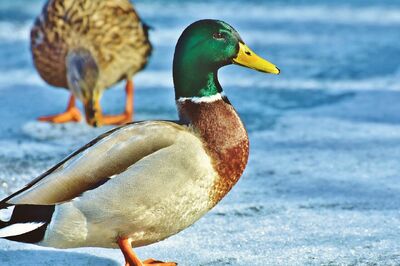Historically, Europe has been affected by four major disease waves of highly pathogenic avian influenza (HPAI) of subtype H5Nx in 2005-2006, 2006-2007, 2016-2017 and 2019-2020 until 2020. Despite the irregular occurrence, seasonality has been regularly observed in the surveillance data, corresponding to the occurrence of low pathogenic avian influenza in wild birds in temperate zones.
H5Nx HPAI infection usually occurred in the autumn (October-December) and these newly introduced strains then spread across Europe in a wave of infection, the intensity of which usually decreased from the spring of the following calendar year (April-June). During the summer, H5Nx strains disappeared completely or were detected very sporadically. The next wave was caused by numerous invasions of H5Nx HPAI strains from outside Europe. These strains showed a wide geographical diversity depending on the season, ranging from Russia to the Middle East and Africa.
However, from summer 2021, there will be a paradigm shift in the infectious dynamics of H5N1 HPAI in Europe from epizootic to enzootic infection. This means that the virus will persist in the European wild bird population and potentially become a continuous source of infection. The infection wave following this ecological change was the most severe ever recorded in Europe, both in terms of geographical spread and the number of poultry culled. Resident strains may be an important parallel or even exclusive source of H5N1 virus for the next season. This represents an entirely new dimension of risk for commercial poultry.
At the department of molecular biology, SVU Prague, we have been monitoring the circulation of the H5Nx virus in the Czech Republic since its first appearance in 2006, analysing its genetic variants, monitoring the relationships between outbreaks and determining its relationship to other European outbreaks. We are submitting the genome sequences to an international database and our results form the basis of regular reports to the European reference laboratory.
List of publications from our professional activities:
Nagy A, Černíková L, Sedlák K. Genetic data and meteorological conditions: unravelling the windborne transmission of H5N1 high-pathogenicity avian influenza between commercial poultry outbreaks. https://www.biorxiv.org/content/10.1101/2025.02.12.637829v1
Fusaro A, Zecchin B, Giussani E, Palumbo E, Agüero-García M, Bachofen C, Bálint Á, Banihashem F, Banyard AC, Beerens N, Bourg M, Briand FX, Bröjer C, Brown IH, Brugger B, Byrne AMP, Cana A, Christodoulou V, Dirbakova Z, Fagulha T, Fouchier RAM, Garza-Cuartero L, Georgiades G, Gjerset B, Grasland B, Groza O, Harder T, Henriques AM, Hjulsager CK, Ivanova E, Janeliunas Z, Krivko L, Lemon K, Liang Y, Lika A, Malik P, McMenamy MJ, Nagy A, Nurmoja I, Onita I, Pohlmann A, Revilla-Fernández S, Sánchez-Sánchez A, Savic V, Slavec B, Smietanka K, Snoeck CJ, Steensels M, Svansson V, Swieton E, Tammiranta N, Tinak M, Van Borm S, Zohari S, Adlhoch C, Baldinelli F, Terregino C, Monne I. High pathogenic avian influenza A(H5) viruses of clade 2.3.4.4b in Europe-Why trends of virus evolution are more difficult to predict. Virus Evol. 2024 Apr 6;10(1):veae027. DOI: 10.1093/ve/veae027
Nagy A, Stará M, Černíková L, Kličková E, Horák O, Hofmannová L, Sedlák K. Enzootic Circulation, Massive Gull Mortality and Poultry Outbreaks during the 2022/2023 High-Pathogenicity Avian Influenza H5N1 Season in the Czech Republic. Viruses. 2024 Jan 31;16(2):221. DOI: 10.3390/v16020221
Nagy A, Stará M, Černíková L, Hofmannová L, Sedlák K. Genotype Diversity, Wild Bird-to-Poultry Transmissions, and Farm-to-Farm Carryover during the Spread of the Highly Pathogenic Avian Influenza H5N1 in the Czech Republic in 2021/2022. Viruses. 2023 Jan 20;15(2):293. DOI: 10.3390/v15020293
Nagy A, Černíková L, Stará M, Hofmannová L, Sedlák K. Genotype Uniformity, Wild Bird-to-Poultry Transmissions, and Farm-to-Farm Carryover during the Spread of the Highly Pathogenic Avian Influenza H5N8 in the Czech Republic in 2021. Viruses. 2022 Jun 28;14(7):1411. DOI: 10.3390/v14071411
Pohlmann A, King J, Fusaro A, Zecchin B, Banyard AC, Brown IH, Byrne AMP, Beerens N, Liang Y, Heutink R, Harders F, James J, Reid SM, Hansen RDE, Lewis NS, Hjulsager C, Larsen LE, Zohari S, Anderson K, Bröjer C, Nagy A, Savič V, van Borm S, Steensels M, Briand FX, Swieton E, Smietanka K, Grund C, Beer M, Harder T. Has Epizootic Become Enzootic? Evidence for a Fundamental Change in the Infection Dynamics of Highly Pathogenic Avian Influenza in Europe, 2021. mBio. 2022 Aug 30;13(4):e0060922. DOI: 10.1128/mbio.00609-22
Nagy A, Černíková L, Stará M. A new clade 2.3.4.4b H5N1 highly pathogenic avian influenza genotype detected in Europe in 2021. Arch Virol. 2022 Jun;167(6):1455-1459. DOI: 10.1007/s00705-022-05442-6
Nagy A, Dán Á, Černíková L, Vitásková E, Křivda V, Horníčková J, Masopust R, Sedlák K. Microevolution and independent incursions as main forces shaping H5 Hemagglutinin diversity during a H5N8/H5N5 highly pathogenic avian influenza outbreak in Czech Republic in 2017. Arch Virol. 2018 Aug;163(8):2219-2224. DOI: 10.1007/s00705-018-3833-7
Nagy A, Cerníková L, Jiřincová H, Havlíčková M, Horníčková J. Local-scale diversity and between-year "frozen evolution" of avian influenza A viruses in nature. PLoS One. 2014 Jul 30;9(7):e103053. DOI: 10.1371/journal.pone.0103053
Nagy A, Cerníková L, Křivda V, Horníčková J. Digital genotyping of avian influenza viruses of H7 subtype detected in central Europe in 2007-2011. Virus Res. 2012 May;165(2):126-33. DOI: 10.1016/j.virusres.2012.02.005
Nagy A, Vostinakova V, Pindova Z, Hornickova J, Cernikova L, Sedlak K, Mojzis M, Dirbakova Z, Machova J. Molecular and phylogenetic analysis of the H5N1 avian influenza virus caused the first highly pathogenic avian influenza outbreak in poultry in the Czech Republic in 2007. Vet Microbiol. 2009 Jan 13;133(3):257-63. DOI: 10.1016/j.vetmic.2008.07.013
Nagy A, Machova J, Hornickova J, Tomci M, Nagl I, Horyna B, Holko I. Highly pathogenic avian influenza virus subtype H5N1 in Mute swans in the Czech Republic. Vet Microbiol. 2007 Feb 25;120(1-2):9-16. DOI: 10.1016/j.vetmic.2006.10.004
Holko I, Machova J, Hornickova J, Tomci M, Nagl I, Horyna B, Nagy A. Highly pathogenic avian influenza in the Czech Republic. Vet Rec. 2006 May 27;158(21):741-2. DOI: 10.1136/vr.158.21.741-e





